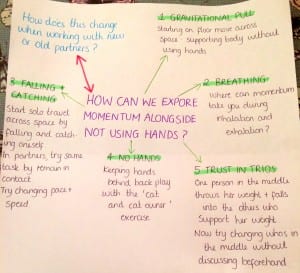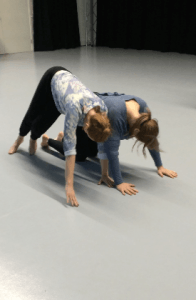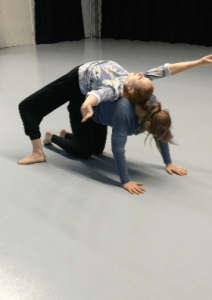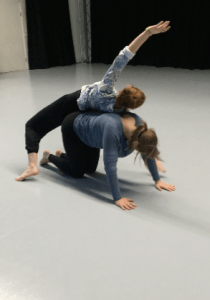Carrying on from the week before, we decided on the question ‘how can we explore momentum alongside the idea of coming off the floor without using the support of our hands and how does this change when working with new or old partners?’
Relating to David Lepkoff’s Contact Improvisation: A Question I’ve realised the importance of continuously asking questions throughout my practice as it can not only define a new movement form but is “a way for the body’s innate ability to respond physically to it’s environment”. Therefore exploring new questions enhances the move away from structured, habitual movement and allows me to really explore my physical potential.
In order to explore and answer this, we devised a number of tasks that focused on the sensation of clasping or unclasping hands. To begin with we started on the floor travelling across the space integrating both skinsphere and upper and lower kinesphere, without using our hands. Like the majority of the group, I naturally clasped my hands, even though this was not discussed beforehand. Clasping my hands personally made it easier to move, as I didn’t have the temptation or felt I had to rely on their support and instead focused on other body parts to hold my weight such as my elbows or shoulders. Dynamically my movement became sustained and controlled as I tried to push, pull and roll around the space so much so I began to contort my body into different shapes and explore how I could fit my torso or legs through the space between my arms and clasped hands. I also found that I was spatially more aware of my surroundings, changing levels continuously as I followed the momentum of my clasped hands swinging to pull my body around the space. Although I personally felt comfortable in my exploration, the members of the group observing us thought the movement looked tense, restricted and repetitive as we returned to body parts we felt comfortable moving, primarily my back or elbows. Halfway through, we were asked to unclasp our hands, which at first I found really difficult as I was constantly aware my hands were free from contact but unavailable to use making my movement seem tense and awkward. However in the discussion afterwards, the observing members of the group brought to attention the sudden shift in momentum when our hands were unclasped, as our movement became freer and effortless as we were no longer restricted by the tension held in the body with the hands clasped together. Although I found myself using my upper kinesphere a lot more and energetically shifting through space at a faster pace than before, I still maintained tension in my hands as a way to remind myself not to support my weight through my hands.

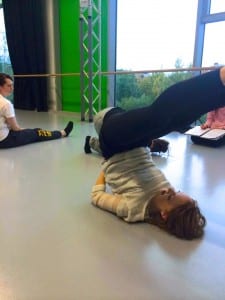
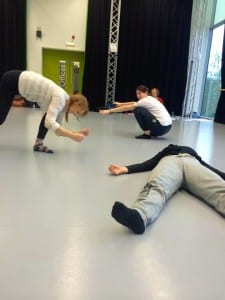 Developing the idea of releasing tension in our bodies, we began to focus on inhalation and exhalation. To do this, we rested in our anatomical neutral position focusing on relaxing the muscles and releasing tension on every exhalation of the breath. We also focused on the idea of giving our weight into the ground and keeping our head heavy. Afterwards, we repeated the first task to see if the awareness of breath and releasing tension would have an impact on our movement or dynamics. Straight away I lost tension in my fingers and palm of my hands that I previously had when I was told to unclasp my hands, which in turn allowed my movement to become fluid and graceful as I gave into momentum and let it lead my body around the space. With this task, I was able to understand the importance of having a relaxed body during contact improvisation as it not only allows you to give weight to the floor or partner and release rigidity but also allows you to give into momentum effortlessly.
Developing the idea of releasing tension in our bodies, we began to focus on inhalation and exhalation. To do this, we rested in our anatomical neutral position focusing on relaxing the muscles and releasing tension on every exhalation of the breath. We also focused on the idea of giving our weight into the ground and keeping our head heavy. Afterwards, we repeated the first task to see if the awareness of breath and releasing tension would have an impact on our movement or dynamics. Straight away I lost tension in my fingers and palm of my hands that I previously had when I was told to unclasp my hands, which in turn allowed my movement to become fluid and graceful as I gave into momentum and let it lead my body around the space. With this task, I was able to understand the importance of having a relaxed body during contact improvisation as it not only allows you to give weight to the floor or partner and release rigidity but also allows you to give into momentum effortlessly.
Next we focused on trust within the group in which one member would stand in the middle and the rest created a safe, compact circle around her. The person in the middle would then fall in all directions leaving their feet parallel on the floor, relying on the people around to catch their weight and push them back and across the circle. This exercise primarily focused on the importance of giving and taking weight as well as succumbing to momentum with a relaxed, comfortable body frame. On observing other members of the group in the middle, it was clear that as they began to fall their body harboured tension as they were holding back from fully falling into the people around them even though they could see we would always be there to catch their weight and push them back. When the person in the middle closed their eyes, movement was much more relaxed and they began to give their weight to the people around them giving into the idea that momentum would be constantly moving them around the circle. When I was in the middle, I felt nervous at first to fall into the rest of the group as I was taller than most of them and worried they wouldn’t be able to hold my weight. However as I eased into the movement I realised that keeping my body relaxed would make it easier to not only follow the momentum of the direction I was being pushed into but also if my body was free from tension it was easier for the people around to catch and push my weight. We also experimented with widening the circle to see how far the person in the middle would fall. What was interesting was not a single person put their hands out to catch themselves as they had complete faith in the rest of the group and gave into the momentum of falling and returning to the middle, which not only highlights how trust can affect your movement quality but also how giving into momentum can release tension and keep your body relaxed and free.
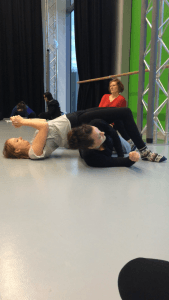 Our last task was returning to the cat exercise we did in the previous week, supporting each other’s weight and exploring moments of balance and contact without the use of our hands. With our hands clasped together, I found it easier to trust and balance on my partner as we constantly kept changing between upper and lower kinesphere. Primarily I used my head or back to initiate the movement replacing the temptation to use my hands however when my hands were unclasped, movement was initiated from my feet and stomach as I pushed or rolled over my partner. I felt safer nearer the floor when our hands were unclasped and realised we didn’t explore the upper kinesphere at all, when watching the extracts of our duet that we videoed. With our hands unclasped, the movement became dynamically heavy and clumpy as we began to think about our movement, focusing on using different body parts to support our weight instead of giving into the momentum of one another’s movement.
Our last task was returning to the cat exercise we did in the previous week, supporting each other’s weight and exploring moments of balance and contact without the use of our hands. With our hands clasped together, I found it easier to trust and balance on my partner as we constantly kept changing between upper and lower kinesphere. Primarily I used my head or back to initiate the movement replacing the temptation to use my hands however when my hands were unclasped, movement was initiated from my feet and stomach as I pushed or rolled over my partner. I felt safer nearer the floor when our hands were unclasped and realised we didn’t explore the upper kinesphere at all, when watching the extracts of our duet that we videoed. With our hands unclasped, the movement became dynamically heavy and clumpy as we began to think about our movement, focusing on using different body parts to support our weight instead of giving into the momentum of one another’s movement.
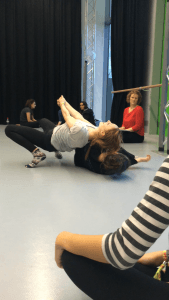 Overall I think we successfully explored ways to use momentum not only individually but also with a partner or a whole group. We realised that to give and take someone’s weight during contact improvisation, the body needs to be relaxed and move effortlessly, following the momentum and sense of direction of the movement which will therefore move away from any habitual, conscious actions. Additionally it was interesting not being able to use our hands, clasped or unclasped, and made me aware of different body parts such as my head, back and feet that can initiate movement as well as support other’s weight and balances. It’s also made me aware that fully trusting the people you’re dancing with can release tension in the body, unconsciously create original, non-habitual movement and allow you to ease and relax into the momentum of the movement. I would like to explore how this changes working with new or old partners a lot more and hopefully will be able to do this in the coming weeks, as well as maintain my exploration of using different body parts to support mine and other’s weight instead of relying on my hands.
Overall I think we successfully explored ways to use momentum not only individually but also with a partner or a whole group. We realised that to give and take someone’s weight during contact improvisation, the body needs to be relaxed and move effortlessly, following the momentum and sense of direction of the movement which will therefore move away from any habitual, conscious actions. Additionally it was interesting not being able to use our hands, clasped or unclasped, and made me aware of different body parts such as my head, back and feet that can initiate movement as well as support other’s weight and balances. It’s also made me aware that fully trusting the people you’re dancing with can release tension in the body, unconsciously create original, non-habitual movement and allow you to ease and relax into the momentum of the movement. I would like to explore how this changes working with new or old partners a lot more and hopefully will be able to do this in the coming weeks, as well as maintain my exploration of using different body parts to support mine and other’s weight instead of relying on my hands.
Jam
This weeks jam I wanted to continue my focus on the use of momentum and explore working with new people. At the beginning, we focused on relaxing our bodies and giving our weight to the floor and our partner, which I found really useful to calm and release tension in the body that had built up throughout the day. This therefore allowed me to maintain a relaxed, effortless dynamic as we eased into the rest of the jam. As a group I think there was a sense of comfortability and trust as we moved from partner to partner – the fact the lights were switched off enhanced this relaxed atmosphere. There was one point that a group of us were clumped together, rolling over one another and a sudden shift in dynamics meant Robyn and I were thrusted out of the group as we continuously rolled over one another. Discussing this afterward, we both agreed that we fully gave into the momentum of the movement which we probably would have restricted in previous weeks.
Citations
Lepkoff, D. (2008) Contact Improvisation: A Question? [online] Available from http://www.daniellepkoff.com/Writings/CI%20A%20question.php [Accessed 25 October 2014]
Lepkoff, D. (1999) What is Release Technique? [online] Available from http://www.daniellepkoff.com/Writings/What%20is%20Release.php [Accessed 25 October 2014]

